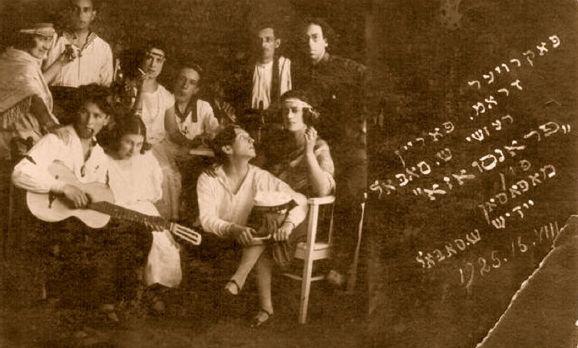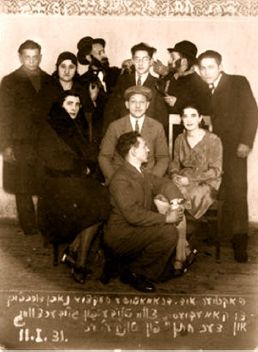My Fathers' name was Faivelis Kremeris. His father was Rabbi in the Slat village (Birzai district including several small communities). I was told by my dad that we are descendants of the Gaon of Vilna. ( whose name was: Elijahoe Shlomo Ben Zalman Kramer ).
My dad married Beila Golda Furman and after the wedding he went back to continue his studies at Shlabotka Yeshiva. He came back to Pakroi when my eldest sister Ella was born. My dad was very involved in Communal Work. He founded and was the treasurer of the Folks bank *) and Chairman of the Educational Committee. He was the Representative on the District Board . He was also the local Mohel Gabbi of the Shull and Shochet . ( etc.) For a living we had a grocery store that my mother handled. My father also had a lime kiln where the lime stones were burnt for nights & days to produce lime, as well as selling and buying lime seed. My Dad was very friendly with Rabbi Tchekanosky **) and they spent much time together.
My family consisted of three brothers : Ben Zion Benny, Yehuda Julius, Shmuel Sam, and two sisters Ella and Zlatta Jeanny and of course myself Mechem Mendel Monty. All were born in Pakroi except for Sam who was born in Achtirka in the Ukraine, whence the Jews were expelled during the first world war,- Probably the first Jews to come to S.A. (South Africa) were from Pakroi some time at the end of the 19th century or at the beginning of the 20th. My mothers' three brothers were among them. They went to S.A., because of the intolerable situation of the Jews in Lita. About 1911 my dad joined them in S.A. But came back to Lithuania just before the first world war. He could not tolerate the way of life there.
In1927 one of my mothers' brothers came to see my Bobba ( grandmother) in Pakroi. To mark that visit he presented in Bobbas &mothers' name a Torah Scroll to the community. (as you can see in the photo.). My mothers' brother persuaded mother to let him take back with him my eldest two brothers (Benny & Julius).He promised to educate them and provide with all they would need. When they got to S.A. my mothers' brother put them to work in one of his concession stores. Despite their unhappiness they managed to save up enough money to bring over my eldest sister in 1929. My dad and my brother Sam came to S.A. in 1936 and finally my mother, Jenny & I came in 1937.
My address in Pakroi was 23, Darius & Gironas gatve ( street), named after the two Lithuanian pilots who flew across the Atlantic. Our house was made of wood. Our outbuilding consisted of a shed to store wood for winter, a stable for the horse and a cow and another shed for the cart and two big warehouses for the lime and flax. Inside we had the shop on the corner then a large living room, a lounge, three bedrooms and a kitchen with a huge oven for baking bread, matzos etc. as well as a stove for daily cooking. From the kitchen there was a staircase leading to the attic that extended over the ceiling of the whole house. We had a very large garden at the back of the house and we grew enough vegetables for both summer & winter, i.e. cabbage and potatoes. We had a well for water. There was no running water, no toilets in the house and for a bath we had a big tube. All the heating was by means of chopped up wood.
There were three shuls in Pakroi. The big Wooden Structure was used only
in summer, as it was too big to be heated in winter. The main Beth
Knesset was used throughout the year and the
"shtibble" ***) was used
mostly by the artisans and the poorer section. This may surprise you,
but from what I remember, there was a definite distinction between the
various levels.
A corner of the big Shul was converted into two classrooms. The community hired two qualified teachers and every child went to school that was graded according to age. so in fact , we had four grades learning simultaneously. At the end of the fourth grade there was a public exam conducted by the Education Ministry and those who passed were entitled to go to Gymnasia. The language used was Yiddish, but of course Bible and Hebrew as all other subjects were in Lithuanian. The public Exam was conducted in Lithuanian. The Rabbi examined us in Hebrew. For the majority that in fact was the end of their formal education as very few could afford to go on to Gymnasia. I personally was lucky as about six months after leaving school we left for S.A., so that all my higher education was in Johannesburg.
There were no pavements in the streets The two main streets were of cobble stones. In spring & autumn we wallowed in mud.
There was no fraternizing with the "shkotchim". In fact we tried to keep out of their way, as otherwise fist fight was the order of the day.
Cynthia Chasan, nee Furman wrote about the gift of the Torah Scroll to the Jewish Community of Pakruojis in 1927 by her father Solly Furman and her mother Milly:
I was only 3 years old but I have distinct memories of the dark house my grandmother lived in and being given nuts and carrots to nibble, going to shul where the women sat behind a curtain, and swimming in a river with my mom.
*) Monty: Practically all the charities etc. were handled by the Folks Bank. That bank was indeed the backbone of the community. Loans were issued, money collected and the teachers were paid etc .Donations at the Shul were all given to the Community Fund at the bank.
**) Rabbi Tchekanosky died a natural death in1940, before the Nazis but under the Soviets. He had three sons. The youngest one was known as Fishel, but this was not his real name. Fishel came to South Africa. He had a damaged hip and walked with a limp. He married a woman much younger than himself. I think they had a boy, but I am not sure. They got divorced . I was a poleholder at his wedding but lost touch with him when I came to Israel. He died in the nineteen seventies in Israel.
Remark (source Rochel's (Morgenstern) story): Fishel was also called Check. He was born in1905 and he emigrated to South Africa in the late thirties, when he first lived in Johannesburg and then in Cape Town. After having been imprisoned as a communist in 1960, Check emigrated to Israel.


Here are two pictures of Check as a member of the Pakroya Theatrical Society, one from1925, the other from 1931. In both, he is in front, in profile. The 1925 photo on the left is the group photo from their production of a play based on a de Maupassant story, as translated into Yiddish by S. Sabal.
Another son was called Yankel (Shmuel) who married Malka Reichman and they had three children. All of them were murdered in 1941.
Another son, Avraham, was a popular football player in Pakruojis. He studied pharmacology in Kaunas and presumably was murdered in1941.
A daughter- name unknown- did not return to Lithuania from Russia, after World War I, but remained there to study and later lived in the Asian republic of Kirghizstan.
***) The "shtibble" is your neighborhood house of prayer and Torah learning. Some people drop in just to chat, to catch up on the news, to have a cup of coffee and a piece of honey cake, or to seek advice from the rabbi. Come on inside, you're more than welcome.
Note: In 2007 Jonathan Levine from New York wrote me that Chatzkel Kremer from Pakruojis married Sora Esther Yuter from Panevezys.